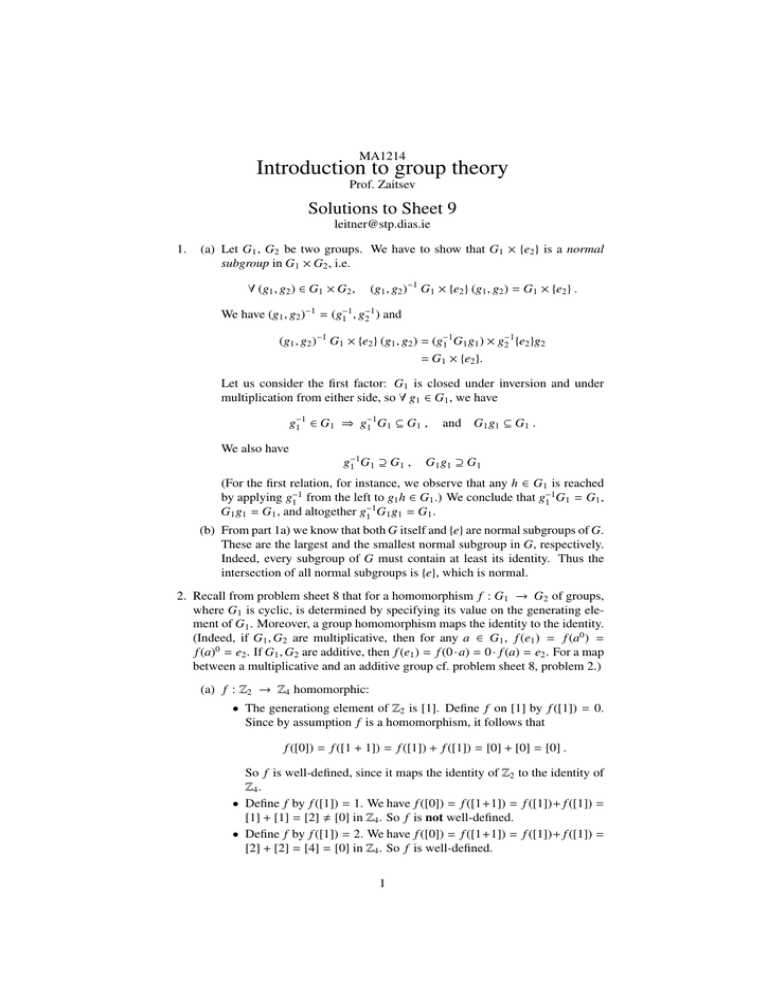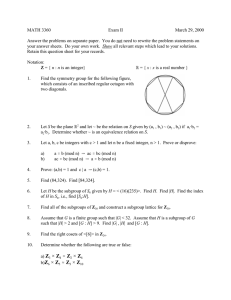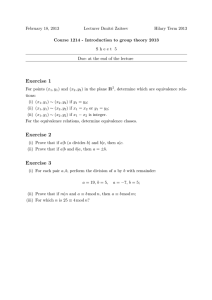Introduction to group theory Solutions to Sheet 9
advertisement

MA1214
Introduction to group theory
Prof. Zaitsev
Solutions to Sheet 9
leitner@stp.dias.ie
1.
(a) Let G1 , G2 be two groups. We have to show that G1 × {e2 } is a normal
subgroup in G1 × G2 , i.e.
∀ (g1 , g2 ) ∈ G1 × G2 ,
(g1 , g2 )−1 G1 × {e2 } (g1 , g2 ) = G1 × {e2 } .
−1
We have (g1 , g2 )−1 = (g−1
1 , g2 ) and
−1
(g1 , g2 )−1 G1 × {e2 } (g1 , g2 ) = (g−1
1 G 1 g1 ) × g2 {e2 }g2
= G1 × {e2 }.
Let us consider the first factor: G1 is closed under inversion and under
multiplication from either side, so ∀ g1 ∈ G1 , we have
−1
g−1
1 ∈ G 1 ⇒ g1 G 1 ⊆ G 1 ,
and G1 g1 ⊆ G1 .
We also have
g−1
1 G1 ⊇ G1 ,
G 1 g1 ⊇ G 1
(For the first relation, for instance, we observe that any h ∈ G1 is reached
−1
by applying g−1
1 from the left to g1 h ∈ G 1 .) We conclude that g1 G 1 = G 1 ,
−1
G1 g1 = G1 , and altogether g1 G1 g1 = G1 .
(b) From part 1a) we know that both G itself and {e} are normal subgroups of G.
These are the largest and the smallest normal subgroup in G, respectively.
Indeed, every subgroup of G must contain at least its identity. Thus the
intersection of all normal subgroups is {e}, which is normal.
2. Recall from problem sheet 8 that for a homomorphism f : G1 → G2 of groups,
where G1 is cyclic, is determined by specifying its value on the generating element of G1 . Moreover, a group homomorphism maps the identity to the identity.
(Indeed, if G1 , G2 are multiplicative, then for any a ∈ G1 , f (e1 ) = f (a0 ) =
f (a)0 = e2 . If G1 , G2 are additive, then f (e1 ) = f (0 · a) = 0 · f (a) = e2 . For a map
between a multiplicative and an additive group cf. problem sheet 8, problem 2.)
(a) f : Z2 → Z4 homomorphic:
• The generationg element of Z2 is [1]. Define f on [1] by f ([1]) = 0.
Since by assumption f is a homomorphism, it follows that
f ([0]) = f ([1 + 1]) = f ([1]) + f ([1]) = [0] + [0] = [0] .
So f is well-defined, since it maps the identity of Z2 to the identity of
Z4 .
• Define f by f ([1]) = 1. We have f ([0]) = f ([1+1]) = f ([1])+ f ([1]) =
[1] + [1] = [2] , [0] in Z4 . So f is not well-defined.
• Define f by f ([1]) = 2. We have f ([0]) = f ([1+1]) = f ([1])+ f ([1]) =
[2] + [2] = [4] = [0] in Z4 . So f is well-defined.
1
• Define f by f ([1]) = [3]. We have f ([0]) = f ([1 + 1]) = f ([1]) +
f ([1]) = [3] + [3] = [6] = [2] , 0 in Z4 . So f is not well-defined.
The map f ([1]) = [m] for any [m] ∈ Z4 with
m + m = 2m ≡ 0
mod 4
is well-defined.
(b) f : Z2 → Z5 homomorphic:
• Define f by f ([1]) = 0. We have f ([0]) = f ([1+1]) = f ([1])+ f ([1]) =
[0] + [0] = [0]. So f is well-defined.
• Define f by f ([1]) = 1. We have f ([0]) = f ([1+1]) = f ([1])+ f ([1]) =
[1] + [1] = [2] , [0] in Z5 . So f is not well-defined.
• Define f by f ([1]) = 2. We have f ([0]) = f ([1+1]) = f ([1])+ f ([1]) =
[2] + [2] = [4] , [0] in Z5 . So f is not well-defined.
• Define f by f ([1]) = [3]. We have f ([0]) = f ([1 + 1]) = f ([1]) +
f ([1]) = [3] + [3] = [6] = [1] , [0] in Z4 . So f is not well-defined.
• Define f by f ([1]) = [4]. We have f ([0]) = f ([1 + 1]) = f ([1]) +
f ([1]) = [4] + [4] = [8] = [3] , [0] in Z4 . So f is not well-defined.
5 is not divisible by 2, so
m + m = 2m ≡ 0
mod 5
is solved by [m] = [0] only. The only homomorphism is the trivial map.
3. Recall that the order of a group is the number of its elements. Z8 = {[0], . . . , [7]}
has order 8.
(a) Denote by [4] be the equivalence class mod 8. h[4]i = {[0], [4]} defines a
subgroup of Z8 of order two. So
Z8 /h[4]i = {[0], [1], [2], [3]}
has order 8 : 2 = 4 and is cyclic, generated by [1].
(b) We have
3=3≡3
mod 8
3+3=6≡6
mod 8
3+3+3=9≡1
mod 8
3 + 3 + 3 + 3 = 12 ≡ 4
mod 8
3 + 3 + 3 + 3 + 3 = 15 ≡ 7
mod 8
3 + 3 + 3 + 3 + 3 + 3 = 18 ≡ 2
mod 8
3 + 3 + 3 + 3 + 3 + 3 + 3 = 21 ≡ 5
mod 8
3 + 3 + 3 + 3 + 3 + 3 + 3 + 3 = 24 ≡ 0
mod 8 .
By adding another copy of 3, we restart from above. We observe that all
numers between 0 and 7 occur, so that the subgroup h[3]i actually equals
Z8 :
Z8 /h[3]i = {[0]} ,
whose order is 8 : 8 = 1. It is trivially cyclic.
More generally, when gcd(m, n) = 1 and [m] denotes the equivalence class mod
n, then h[m]i = Zn .
2







